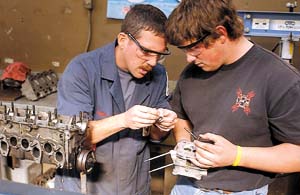A report on last year’s grades prompted the San Benito High
School Superintendent to conclude that the schools experiment with
early morning classes failed to improve student achievement and
that English learners need more instructional support.
Hollister – A report on last year’s grades prompted the San Benito High School Superintendent to conclude that the schools experiment with early morning classes failed to improve student achievement and that English learners need more instructional support.
The report, which shows exactly what grades students got in every class at the school, showed students taking a zero period class, which started early in the morning before regular school day, did not perform as well as students who took the same class later in the day. The same was true for English learner (EL) classes, Superintendent Jean Burns Slater said.
“The zero period was a disaster,” she said. “Teenagers don’t do well that early in the morning.”
In order to improve grades, the district has already purchased new textbooks designed specifically for EL students and will be looking into new professional development classes for teachers, Slater said. Slater believes the school’s new schedule, which no longer includes a zero period, will be more effective also.
The rate of failure in some EL classes were particularly troublesome, Board of Trustees member Evelyn Muro said. For example, in one EL Economics class 75 percent of the students failed and the other 25 percent received C’s.
“I don’t think that students learn anything from getting an F,” Muro said. “If they haven’t learned it, we haven’t taught it.”
Grades, Muro said, indicate not only how well students are doing, but also how well teachers are doing. Muro hopes the district will look closely at the grade report data.
“It’s really important to look at the grades across the board – it’s the currency of the institution,” she said. “This (report) should really provoke discussion.”
More discussion is needed in order to make sure both teachers and administrators are clear on exactly what is working in the classroom and what isn’t, Muro said.
Grades are a shared responsibility between students and teachers, Slater said. Students are required to put in the effort, while teachers need to make sure their grading policies are reasonable, she
Junior Isela Bradle believes that students are almost entirely responsible for their grades.
“About 90 percent of the time, it’s the student’s fault that they have a bad grade,” she said.
Bradle said that the classroom environment can make a big difference. In advanced placement classes, where “everyone wants to learn,” it is easier to focus than in regular classes, where “students don’t care,” she said.
Tom Agan, who teaches auto mechanics, believes every student is given the opportunity to succeed.
“It’s totally up to the student,” Agan said. “You may not be a rocket scientist and get the ‘A’, but you can still get a good grade.”
Brett Rowland covers education for the Free Lance. He can be reached at 831-637-5566 ext. 330 or br******@***********ws.com.










